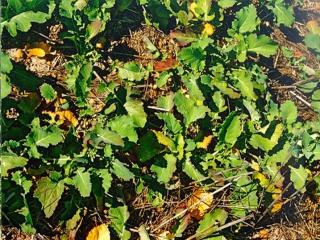Canola and cereal virus infection in volunteers
As part of a survey of virus infection in volunteer crop plants and weeds from across the wheatbelt, DAFWA Crop protection agronomists at Albany, Esperance, Merredin, Northam and Geraldton have been submitting cereal, canola and weed samples for virus testing.
Virus infection in crops at early growth stages poses the greatest risk of yield losses from these virus diseases. This can occur when virus vectors such as aphids and mites spread virus from infected volunteer plants or weeds to newly emerging crops. Ensuring that volunteer plants are grazed out or completely dead prior to crop emergence will significantly reduce virus inoculum reservoirs and risk associated with these diseases.
Beet western yellows virus
- Toodyay
- Irishtown
Plant virologist Ben Congdon (DAFWA) reports that at the time of writing, canola or wild radish had been submitted from more than 30 sites from a wide range of Wheatbelt locations, with beet western yellow virus (BWYV) detected in wild radish from two sites at Toodyay and Irishtown. Although BWYV was below detection level (100 plants) in most of these samples, infection reservoirs may still be present at all sites tested. These reservoirs will increase in magnitude following the build-up of autumn aphid vector populations on wild radish.
For further details on identifying and managing this virus refer to DAFWA’s Diagnosing beet western yellow virus in canola.
Wheat streak mosaic virus
- Esperance
- Lake Grace
- Corrigin
From approximately 25 sites of cereal volunteers, wheat streak mosaic virus (WSMV) was detected at low levels from three sites in the Esperance, Lake Grace and Corrigin regions. These levels of detection are similar to previous seasons and indicate that low levels of inoculum are present in some green bridge volunteers. In paddocks or regions where this disease has been problematic previously, specific attention to complete removal of volunteers in or adjacent to newly emerging crops is recommended. Barley yellow dwarf virus (BYDV) had not been detected in any samples submitted.
For further details on identifying and managing wheat steak mosaic virus refer to DAFWA's Diagnosing wheat streak mosaic virus and Wheat streak mosaic virus and wheat curl mite.
Green bridge insect or disease observations can be reported through the MyPestGuide Reporter app, using the Green bridge survey tab.
Volunteer crop and weed regrowth and early sown crop samples can be submitted to DAFWA virology for virus testing.
For further information contact South Perth based plant virologists Ben Congdon on +61 (0)8 938 3499 or Brenda Coutts on +61 (0)8 9368 3266.


